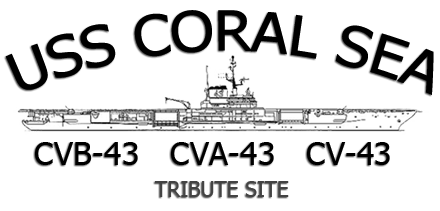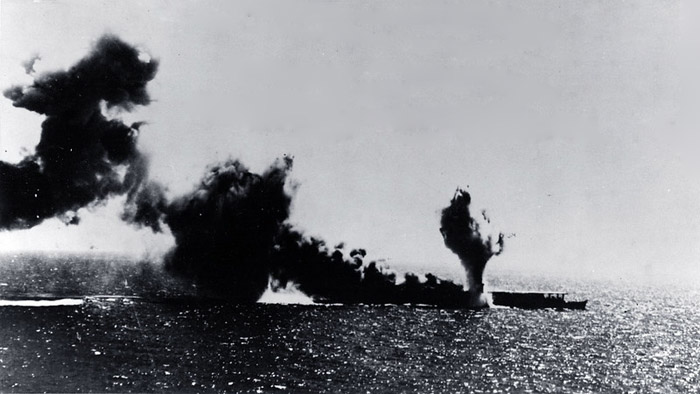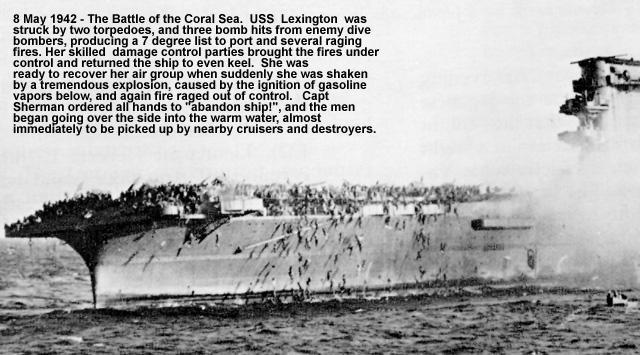
AGELESS WARRIOR
• THE NATURAL
• SAN FRANCISCO'S OWN
• BEST IN THE WEST
• CORAL MARU



The Japanese battle plan, developed by the battle staff of Admiral Yamamoto, was set into motion. Called Operation MO, the plan involved the Invasion of Port Moresby on the Coral Sea. The fall of Port Moresby would lead to an easy conquest of the rest of New Guinea and thereby place Australia itself in great peril. As a preliminary move, a Japanese force seized Tulagi, a small island some 20 miles North of Guadalcanal in the Solomon Islands and began construction of a seaplane base there. Since January, Japanese forces had been staging for regional Pacific operations at Rabaul. On 4 May, the Port Moresby Invasion force consisting of 14 invasion troop transports. escorted by a light cruiser and six destroyers and a covering force consisting of the light carrier Shoho, four heavy cruisers and a destroyer departed the Rabaul staging area and headed to sea.
Most of this information was already known by Admiral Nimitz, whose crypto analysts had broken the Japanese fleet crypto codes. Nimitz had already dispatched a naval force, designated Task Force 17, consisting of two carriers, six heavy cruisers, two light cruisers and eleven destroyers under command of Rear Admiral Frank Fletcher. Their mission--to intercept the Japanese fleet now steaming from Rabaul. On the afternoon of the 6th of May, enemy forces had become sufficiently consolidated in the Bismarck Archipelago-New Guinea region to indicate amphibious operation to the southward. As enemy forces moving against Port Moresby, the most likely target, would have to round the southeastern end of New Guinea. Rear Admiral Fletcher stationed an attack group within striking distance Of the probable track of the enemy fleet and the remainder of his force moved northward in an attempt to locate the enemy covering force.
Admiral Fletcher's forces had reached the Coral Sea of northeastern Australia by the time of the Tulagi landing. Fletcher immediately launched a ninety nine plane air attack toward Tulagi from his flagship, the carrier Yorktown. To counter the unexpected threat from Task Force 17, Japanese Vice Admiral Takeo Takagi was sent south from Bougainville with an additional reinforcing force consisting of two heavy carriers, the Zuikaku and the Shokaku, two heavy cruisers and six destroyers.
As the two opposing forces drew inexorably closer, the first contact was made by Takagi. On the morning of 7 May. one of his search planes spotted the oiler Neosho and a destroyer. Excited by his discovery, the spotter erroneously reported the two ships as an enemy carrier and a cruiser. Responding quickly, two waves of high-level bombers and 36 dive bombers attacked, sinking the destroyer and leaving the oiler mortally wounded and drifting helplessly.
While Takagi concentrated on these relatively minor targets, a strike force of 93 planes from the Yorktown and Lexington found the light carrier Shoho and began an intense bomb and torpedo attack. As the command elements on the United States mother ships strained to make sense of the garbled and excited radio conversations between engaged aircraft, the voice of Lieutenant Commander Robert Dixon came in loud and clear, reporting "Scratch one flattop! Dixon to carrier. Scratch one flattop!" At last, after five long and discouraging months, a Japanese ship larger than a destroyer had been sunk.

Japanese aircraft carrier Shoho is torpedoed and bombed, during attacks by U.S. Navy carrier aircraft in the late morning of 7 May 1942.
In Rabaul, Vice Admiral Shigeyoshi Inoue, overall commander of Operation MO, ordered the transports to turn back and wait until the seas were cleared of the Americans. As the afternoon wore on, visibility decreased and squalls developed, limiting visibility and aerial observation. By midnight, the two fleets had lost contact.
Takagi then signaled Rear Admiral Tadaichi Hara, commander of the two Japanese carriers, querying if he could launch a night air attack. Hara replied that he was prepared to send a force of 27 aircraft. Just prior to dusk they took off but because of limited visibility and worsening weather, they found nothing. However, on the way back to the carriers, the returning Japanese raiders were set upon by a group of Fletcher's fighters. In the ensuing battle, nine Japanese aircraft were shot down; the others dispersed and attempted to return to their home carriers. One cluster of six eventually found a carrier and entered the landing pattern. As the first Japanese aircraft skimmed the deck with its landing hook extended, he was blasted by a hail of gunfire. The aircraft carrier was the Yorktown.
Takagi, reviewing the situation, decided to retire to the north temporarily. After several hours, he doubled back toward the American carriers and just before dawn on 8 May, he dispatched a force of 27 search planes. The first pure carrier battle in the history of warfare was now imminent. Admiral Fletcher had ra dar, but his carriers had operated together as a team for less than a week. Takagi had no radar, but his forces had been together as a coordinated division for more than six months. Fletcher now had 122 planes: Takagi had 121. The overcast weather gave a slight advantage to the attacking Takagi.
The first break, however, went to Fletcher. At 0815 one of his search pilots reported sighting the Japanese Strike Force, radioing that he had spotted two carriers, four heavy cruisers, many destroyers, steering 120 degrees, 20 knots. Their position 175 miles roughly northeast!" Fletcher ordered airstrikes launched from both carriers and around 1100 hours 39 planes from the Yorktown attacked the Shokaku, now screened by heavy cruisers and destroyers. Zuikaku, ten miles away, was hidden by a dense squall. Shokaku avoided hits by torpedo planes, but dive bombers scored two direct hits which started raging fires. Twenty-four planes from the Lexington made up a second wave and found the carriers and attacked aggressively. The Shokaku was hit one more time and, as the aircraft returned to the Lexington. The Shokaku's fires were brought under control and seriously wounded, she left the field of battle and headed for home.
However, the Japanese found the American force almost simultaneously with the American discovery of the Japanese fleet. Seventy planes attacked Fletcher's two carriers. One bomb hit he Yorktown's flight deck, however the fires were quickly brought under control by the Yorktown damage control crews; the Lexington, however, was not so lucky as two torpedoes exploded on her port side and small bombs struck forward on the main deck and into the smokestack structure.
The air attacks had been costly to both sides. By noon the battle was over. It was the first naval engagement in which posing ships never saw each other or changed gunfire.
At this time, it appeared that Fletcher had won. He had sunk a light carrier, a destroyer and three small vessels while losing one destroyer and an oiler. Then. two explosions rocked the stricken Lexington and set off fires that could not be brought under control. Around 1700 hours, the Lexington now almost Impossible to control Rear Admiral Aubrey Fitch, commander of the Carrier Group, informed the Lexington's skipper. Captain Frederick C. Sherman, that it was time to "get the men off."

Nearly all personnel were saved and once everyone was clear of the stricken Lexington, four torpedoes from the destroyer Phelps were fired into the carrier's starboard side. The carrier shuddered and, as Steam continued to rise from within her She slid stern-first beneath the waters, head up and refusing to roll over even at the very end.
With the sinking of the Lentngton, the battle now became a tactical victory for Takagi: however, the strategic triumph belonged to Fletcher. Admiral Inoue was forced to postpone the Port Moresby operation. Fletcher had accomplished his mission and, for the first time since Pearl Harbor. a Japanese invasion had been thwarted.
Takagi, however. Was reluctant to give up. He was preparing to engage the Americans in a night battle when he learned that his own destroyers were almost out of fuel. He then turned back toward Rabaul. Yamamoto was still resolved to pursue the Americans, however, and through communications facilities at Rabaul ordered Takagi to attack in spite of the fuel shortage. Takagi reversed his course to engage, but to late. Fletcher had already vanished.
Thus ended the first major engagement in naval history in which surface ships did not exchange a single shot. Although the loss of the Lexington was keenly felt, the engagement in the Coral Sea effectively checked the Japanese in their advance southward. 0ur losses of one carrier, one tanker, one destroyer and a total of 66 planes were considerably less than the estimated Japanese losses. Our personnel casualties totaled 543.
Tactically, the Battle of the Coral Sea was a Japanese victory. The United States carrier Lexington, plus the Neoshe and Sims were lost during the fight, far out weighing the loss of the Japanese light carrier Shoho. Strategically, however, Coral Sea was a stunning American victory. The Japanese invasion force headed for Port Moresby was forced to turn back, the first such withdrawal of the war. Japanese expansion effectively ended with the turning back of that invasion force, although the war would continue for many more years. And, for the first time, the United States had sunk a major Japanese ship. Additionally, two other large Japanese carriers, the Shokaku and the Zuikaku were forced to return to port for repairs and replacement of lost aircraft. The forced return to port would keep them from participating in the upcoming Battle of Midway. Had those two large carriers been players in that strategically decisive battle, their presence could have been decisive in altering the outcome.
Alter the Battle of the Coral Sea, the carrier became the focus of naval weaponry. Other ships of the fleet now supported the carrier. The carrier became the first true strategic weapons system, fully capable of executing the range of strategic options through the spectrum from establishing a "show the flag" presence to the projection of both surgical, tactical and strategic power on a global basis in support of national policy and military strategy.
And thus is the heritage of the USS Coral Sea....